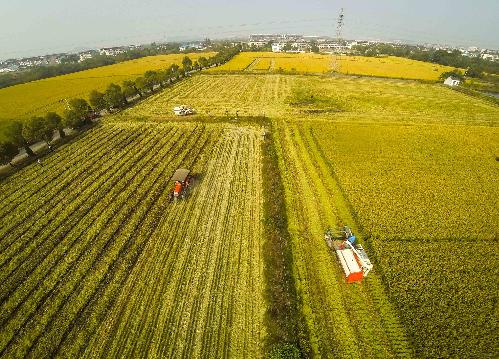|
 |
|
LAND REFORMS BEAR FRUIT: Machines harvest rice in a pilot rural land reform area in Wuxing District, Huzhou, east China's Zhejiang Province, on October 22 (XU YU) |
The Central Economic Work Conference, a much-watched annual economic meeting in China, was held in Beijing from December 9 to 11 to focus on lowering the risks of a downturn and speeding up reforms in key areas with a focus on adjusting to the "new normal" in 2015.
China's central authorities decided at the meeting that the country will stick to its prudent monetary policy and proactive fiscal policy. Fiscal policy will be more forceful in 2015 and monetary policy will strike a balance between tight and loose. Emphasis was put on economic progress while maintaining stability and great significance was attached to structural rebalancing, improving the quality and efficiency of growth.
China has now entered the period of a new normal, demonstrating resilience, massive economic potential and plenty of room for the government to maneuver. According to opinions voiced at the conference, the nation should adapt macroeconomic policies to the new normal and keep growth rate within an acceptable range next year.
During this year's APEC meeting in mid-November, Chinese President Xi Jinping defined the economic new normal as follows: shifting from breakneck economic expansion to moderate to high-speed growth, continuous improvement in the country's economic structure and moving away from factor- and investment-driven growth to innovation-driven growth.
"China's top leadership frequently mentions the 'new normal' because they think structural rebalancing is more important than GDP growth," said Li Yining, a renowned economist and professor at Peking University. "Now is the time for structural adjustment. Missing out on such an opportunity would be a huge loss for China."
Slower, yet steady
China's reform-minded leaders are now showing a greater level of tolerance for slower growth, and they have reiterated on many occasions that the country is capable of maintaining growth "within a proper range."
China's GDP growth slowed to 7.3 percent in the third quarter, the weakest since the global financial crisis, weighed down by a flagging housing market and tighter credit conditions.
Against this backdrop, economists and major financial institutions said the government may lower its GDP target from 7.5 percent to 7 percent. A decision to cut the whole-year growth target for 2015 may have been made during the Central Economic Work Conference, although detailed targets are unlikely to be confirmed and announced until the National People's Congress session in early March next year.
JP Morgan has forecast in a report that China will lower its growth target for 2015 to 7.2 percent while UBS, Bank of China, the Chinese Academy of Social Sciences (CASS) and the State Information Center all have predicted that the target will be lowered to 7 percent.
"It's very much likely that the GDP growth target for 2015 will be lowered to 7 percent," said Zhang Guobao, former Vice Minister of the National Development and Reform Commission (NDRC), China's top economic planner.
Zhang Zhuoyuan, a senior researcher with the CASS, said 7 percent is a more practical target for 2015 and this target will remain the standard for quite some time.
Song Qinghui, a financial commentator, said the growth target shouldn't be set too high so that there could be more room for structural rebalancing and reforms.
"It can't go too low either; otherwise it would cause a spike in bad loans, job losses and business failures. The most important thing to watch out for is employment conditions. Central authorities should keep a close eye on the job market," he suggested.
To prevent further slowdown, China's central bank cut the benchmark one-year lending rate by 0.4 percentage points to 5.6 percent and the one-year deposit rate by 0.25 percentage points to 2.75 percent on November 22.
The long-anticipated rate cut came at a time when the country's economic growth slipped to the lowest in months. "The purpose of the cuts is to bring actual interest rates back to a proper level and lower the financing costs facing many enterprises," the central bank said in a statement.
However, arguments are prevalent in the market that one rate cut alone is far from enough. Other means, such as reducing the reserve requirement ratio (RRR), should be given full play to add liquidity to the market.
A combination of proactive fiscal policy and prudent monetary policy has been in place in China since 2010.
"In 2015, the tone won't be changed, but the monetary policy will be fine-tuned toward being looser. There will be at least one interest rate cut and one reduction of RRR," said Li Huiyong, chief analyst with Shenyin and Wanguo Securities Co. Ltd.
A record-low inflation level also raises the probability of more easing measures by the central bank as it offers more room for monetary loosening.
China's consumer price index (CPI), the main gauge of inflation, rose by 1.4 percent year on year in November, the slowest increase since November 2009, said the National Bureau of Statistics (NBS) on December 10. The producer price index (PPI), which measures inflation at wholesale level, dropped 2.7 percent year on year in November, its largest fall in 18 months.
| 